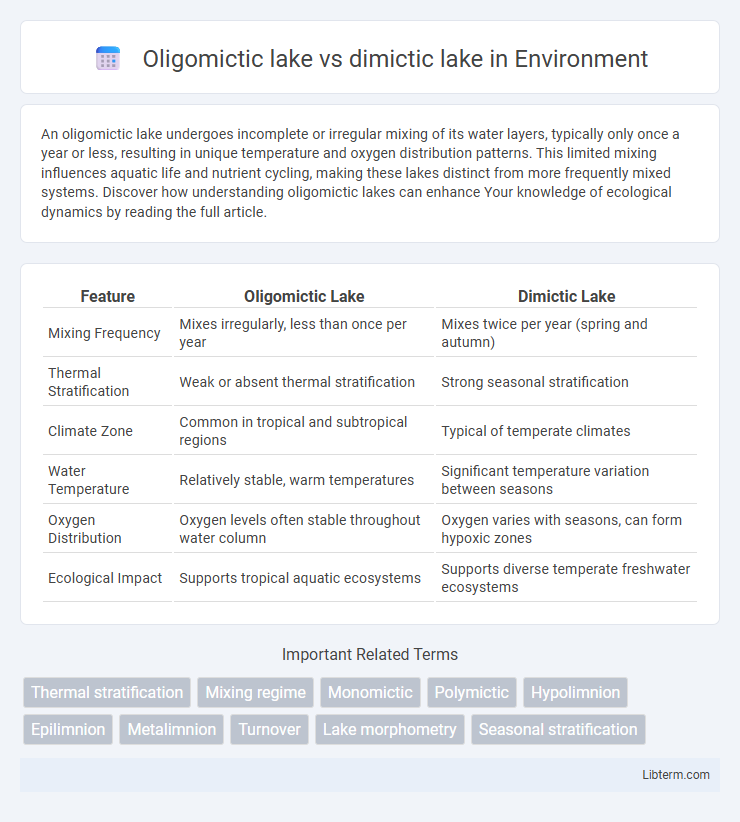An oligomictic lake undergoes incomplete or irregular mixing of its water layers, typically only once a year or less, resulting in unique temperature and oxygen distribution patterns. This limited mixing influences aquatic life and nutrient cycling, making these lakes distinct from more frequently mixed systems. Discover how understanding oligomictic lakes can enhance Your knowledge of ecological dynamics by reading the full article.
Table of Comparison
| Feature | Oligomictic Lake | Dimictic Lake |
|---|---|---|
| Mixing Frequency | Mixes irregularly, less than once per year | Mixes twice per year (spring and autumn) |
| Thermal Stratification | Weak or absent thermal stratification | Strong seasonal stratification |
| Climate Zone | Common in tropical and subtropical regions | Typical of temperate climates |
| Water Temperature | Relatively stable, warm temperatures | Significant temperature variation between seasons |
| Oxygen Distribution | Oxygen levels often stable throughout water column | Oxygen varies with seasons, can form hypoxic zones |
| Ecological Impact | Supports tropical aquatic ecosystems | Supports diverse temperate freshwater ecosystems |
Introduction to Oligomictic and Dimictic Lakes
Oligomictic lakes undergo incomplete or irregular mixing, typically in tropical or subtropical regions, with stratification often broken only a few times annually. Dimictic lakes experience two complete mixing periods each year, usually during spring and autumn, due to temperature-driven turnover in temperate climates. The mixing patterns significantly influence oxygen distribution, nutrient cycling, and aquatic ecosystem dynamics in these lakes.
Defining Oligomictic Lakes
Oligomictic lakes are characterized by mixing rarely, typically only once every several years, due to stable thermal stratification in environments with limited temperature variation. This contrasts with dimictic lakes, which undergo two complete mixing cycles annually during spring and autumn, driven by seasonal temperature shifts. The infrequent mixing in oligomictic lakes affects nutrient distribution and oxygen levels, influencing aquatic ecosystems differently than the regular turnover in dimictic lakes.
Understanding Dimictic Lakes
Dimictic lakes experience two complete mixing periods each year, typically during spring and fall, when temperature stratification breaks down due to cooling water temperatures. These lakes are characterized by distinct thermal layers in summer, with a warm epilimnion and a cold hypolimnion, leading to oxygen and nutrient gradients. Understanding dimictic lakes is crucial for managing aquatic ecosystems, as the seasonal turnover significantly affects oxygen distribution, nutrient cycling, and biological productivity.
Key Differences Between Oligomictic and Dimictic Lakes
Oligomictic lakes mix only once or irregularly per year due to limited temperature variation, typically found in tropical or subtropical regions with stable warm climates. Dimictic lakes undergo two mixing periods annually, in spring and autumn, driven by seasonal temperature changes causing complete turnover of water layers. The key differences lie in mixing frequency, climatic conditions influencing stratification, and oxygen distribution patterns throughout the lake's water column.
Seasonal Mixing Patterns
Oligomictic lakes experience infrequent or irregular mixing, often mixing only once or twice a year due to stable thermal stratification and minimal temperature fluctuations. Dimictic lakes undergo two mixing periods annually, typically during spring and autumn, when surface water temperatures equalize, allowing oxygen and nutrients to circulate throughout the water column. These seasonal mixing patterns influence aquatic ecosystems, nutrient cycling, and water quality differently in each lake type.
Geographic Distribution and Climate Influences
Oligomictic lakes, found primarily in tropical and subtropical regions, experience limited mixing events due to stable, warm temperatures year-round, while dimictic lakes are common in temperate climates where seasonal temperature variations cause two mixing periods typically in spring and autumn. The geographic distribution of oligomictic lakes includes equatorial zones with minimal thermal stratification disruption, whereas dimictic lakes are prevalent in mid-latitude regions with pronounced temperature fluctuations driving thermal overturns. Climate influences such as consistent warmth favor oligomictic patterns by inhibiting complete turnover, contrasting with temperate climates that promote dimictic cycles through marked seasonal cooling and warming phases.
Ecological Impacts of Mixing Regimes
Oligomictic lakes experience limited mixing events, often resulting in prolonged thermal stratification that reduces oxygen circulation and can create anoxic conditions detrimental to aquatic life. Dimictic lakes undergo biannual mixing, typically in spring and autumn, promoting nutrient redistribution and supporting diverse biological communities by maintaining oxygen levels throughout the water column. The differing mixing regimes influence nutrient cycling, sediment oxygenation, and habitat quality, directly impacting fish populations, phytoplankton dynamics, and overall ecosystem productivity.
Biological Communities in Oligomictic vs Dimictic Lakes
Biological communities in oligomictic lakes experience less frequent mixing events, resulting in prolonged stratification that supports specialized species adapted to stable thermal and oxygen gradients. Dimictic lakes undergo thorough mixing twice annually, promoting nutrient redistribution and oxygenation, which supports more diverse and dynamic aquatic ecosystems. These contrasting mixing regimes significantly influence species composition, productivity, and habitat availability in each lake type.
Water Quality and Nutrient Cycling Comparisons
Oligomictic lakes experience limited mixing events, often only partial overturns during specific seasons, resulting in stable thermal stratification that can lead to nutrient accumulation in deeper layers and potentially reduced oxygen levels, impacting water quality negatively. In contrast, dimictic lakes undergo two complete mixing cycles annually during spring and autumn, promoting thorough oxygen distribution throughout the water column and facilitating nutrient recycling from sediments to surface waters, enhancing overall water quality and supporting robust aquatic ecosystems. The differences in mixing regimes between oligomictic and dimictic lakes significantly influence nutrient cycling dynamics, with oligomictic lakes often exhibiting nutrient retention and stratification-driven hypoxia, while dimictic lakes promote nutrient renewal and more balanced oxygen concentrations.
Management and Conservation Considerations
Oligomictic lakes typically experience limited or irregular mixing events, which reduce nutrient redistribution and increase vulnerability to oxygen depletion, necessitating targeted monitoring of thermal stratification and dissolved oxygen levels to prevent fish kills. Dimictic lakes undergo predictable biannual mixing, facilitating nutrient cycling and oxygenation, allowing management practices to focus on controlling external nutrient inputs to avoid eutrophication during stratified periods. Conservation efforts for oligomictic lakes prioritize minimizing anthropogenic disturbances that alter natural mixing regimes, while dimictic lake management emphasizes maintaining water quality through watershed protection and careful regulation of land use.
Oligomictic lake Infographic

 libterm.com
libterm.com